Shortly after Augmented Reality Event – are2010, I talked with Bruce Sterling on skype and in gdocs about his experience there. I am posting the conversation in two parts to make it a more blog friendly length!
The picture above is the Auggie Award for the best AR demo (above) designed by Sigal Arad Inbar. It was won by YDreams! See, Ivan Franco recounts the team’s ARE 2010 experience, and winning the event’s first-ever Auggie Award, for more.  The video below was shot at the YDreams booth by Bruce Sterling.
“The Hotness” – YDreams rocking it at ARE2010 from brucesflickr
Rudy Rucker, who was hanging out with Bruce Sterling, captured the are2010 buzz and some great images in his post, Augmented Reality, Painting, Twitter. As Rudy put it:
“AR is hoping to be a next big thing, a cozier and more commerce-driven cousin of the old VR, or virtual reality.”
Bruce Sterling’s opening key note is up, ARE 2010 Keynote by Bruce Sterling: Bake a Big Pie!, and also the ARE 2010 Keynote by Will Wright: Brilliant Inspiration for the Augmented Reality Community with more videos from are2010 on the way. One must read post on are2010 is Chris Cameron’s post, Augmented Reality’s Next Steps: Sitting Down with the Titans of AR.
Talking with Bruce Sterling, Part 1
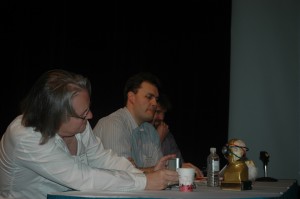
The Auggie panel, Bruce Sterling, Jesse Schell, and Mark Billinghurst inspect the award.
Tish Shute: In your keynote at the 9am of the augmented reality industry you asked some questions of the are2010 audience: “What’s the mission statement? You’re the world’s first pure play experience designers, except that user experience it’s mostly futuristic hot air. But run with that, right? What are your tactical steps? You should get dressed, have a coffee, have a to-do list.”
How much of that did you see going on in the next two days?
Bruce Sterling: Well, I wasn’t privy to any of the business discussions. I didn’t think it was an accident that this standard AR enabled tag thing came up from Bruno Uzzan, Total Immersion. That seemed to me to be a useful thing.  I was always interested in the Augmented Reality Consortium.  It struck me as remarkable that there was this group of people who clearly all knew one another and it had some kind of game plan.  I applaud them for that, because these are not the 1980’s. [laughs] You know, it’s just a different world for young startup companies.
Tish Shute: I think you’re right. There seem to be some VC conversations going on, we don’t know what went on in the meetings, but it was noticeable in the atmosphere of excitement, and remarked on by a few people. So I think that kind of was definitely going on.
And, of course, I was so busy I never even got to see the expo properly! You said you wanted to be surprised.
Did anyone surprise you in any of the talks, in any of the expo?
AR used as interfaces for devices
Italian augmented robot from SEAC02 from brucesflickr
Bruce Sterling: I have to say I was a little bit surprised to see Andrea Carignano demoing a robot. I happen to know him because he’s here in Torino. He’s the guy that came out of Fiat and went into AR. I am not a particularly huge robot fan, but I think it’s of great interest that AR is used as interfaces for devices, as opposed to the Jesse Schell idea that AR is all about a “man with the X-ray eyes.”
My suspicion is that a lot of surprises will come out of mashups of AR.
Tish Shute: I didn’t get to see Andrea’s robot. So what did it do?
Bruce Sterling: It’s basically a sister device to that little helicopter that those Parrot AR Drone guys were doing.  It’s a little autonomous robot and it runs around with a webcam on it. You can place video into the acquisition stream coming off the robot. You can play a game, and blow away imaginary monsters or whatever.
Tish Shute: It’s interesting, because did you notice Will Wright and Patrick O’Shaughnessey, Patched Reality, spend some time hacking the Parrot AR drone in the hallway? Did you come across them?
Bruce Sterling: Rudy was there with them. You know, I didn’t want to watch Will Wright hack a robot.
[laughter]
Tish Shute: They seemed to be having fun even though as it turned out the power supply was dead.
Bruce Sterling: I’m sure Will enjoyed that.  As a game designer, you want to go out and get your hands dirty with a plastic gizmo.
[laughter]
My Swiss Army knife can’t get through airport security, so I really don’t want to strip anything down. But yeah, what else did I see that was of particular interest? I was pretty happy about the Korean guys because they are a difficult group to get close to.
AR companies are like mini-global micro-startups. They’re “glocal”.
“Korean elegance at the Zenitum booth” – from brucesflickr
Tish Shute: Zenitum. What did you like from Zenitum. They were one of our sponsors, along with Qualcomm.
Bruce Sterling: I know that Seoul is like the number one center for augmented reality discussion. But it’s  difficult to get behind the scenes as a journalist there and  track what’s going on in Korea.  I’m fine with Italian “realtà aumentata.”   And I feel like I’ve got a handle on French “réalité augmentée.”  The Germans were not hard to find, and the Dutch all speak English! But the Koreans, and whoever the hell it is in Kuala Lumpur…  I have no idea what’s going in Kuala Lumpur, and only the vaguest idea of what’s transpiring in Singapore!  But I know that people there are paying a coherent interest.
So the Koreans show up, and they had some relatively predictable anime style 3D avatar conversion stuff. But they had a really nice display space.
“Anime figures become three-d smartphone animated avatars,” from brucesflickr
Tish Shute: Ah, So Zenitum created a hot spot at the exhibition?
Bruce Sterling: Yeah.  The Koreans had  IKEA furniture and some nifty little woven baskets. They’d really classed up their presentation.  Most Koreans in tech tend to be kind of muscular.  The Koreans are not known for their refined presentations. On the contrary, they tend to undersell everybody else. But I don’t know, maybe they’ve been hanging out with Samsung and upgrading their design chops. [laughs]
Tish Shute:Â Did you take some photos you could send me?
Bruce Sterling: I took a few, but  I don’t consider myself a photographer.  They’re all up on my Flickr set. It was interesting to see so many people from so many different nations in such a collegial atmosphere.
Tish Shute: Yes – there were many different countries represented at are2010
Bruce Sterling: It’s the beginning… and so global at such a young stage.
Tish Shute: Yes. As you said, it was 9 AM, so everyone was actually super excited to be gathered together from across the globe to start a new day together. As you mentioned, there was a very warm affirmative vibe – everyone sharing a passion.
Bruce Sterling:  They have an online commonality. They seem to be aware of one another’s work through the Internet.
Clearly they had all heard about one another.  That’s a departure from earlier models of tech startup, where you usually have like three hippies in a local garage. Now you’ve got German-American-Korean outfits like Metaio, and Total Immersion has a Russian affiliate.  They’re inherently multinational, both inside the company and out.
Tish Shute: It was the multinational garage, wasn’t it?
Bruce Sterling: Yeah.  AR companies are like mini-global micro-startups. They’re “glocal.” There’s something quite new to me about that. I don’t find it’s shocking, because in Europe today it’s common to find startup teams who are multinational. But to see such intense globalism at such an early stage of an industry is really different.
Tish Shute: Yes it made for a fun atmosphere? It was wonderful running into Iguchi Takahito, Tonchidot. You have a great rapport with each other despite the language barrier?
Bruce Sterling: Yeah.  That guy from Tonchidot, he’s very charismatic. He’s punchy. That’s reflected in the very strong graphic design from his company.
Tish Shute: Using minimal English to make the case for Sekai No Camera at the Auggies, Iguchi Takahito still got through to the audience.
Bruce Sterling:Â Well, his visuals were good.
What AR means for artistic practice…
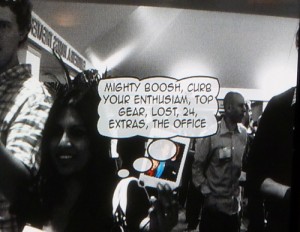
Picture of Eric Gradman’s Cloud Mirror, from James Alliban post ARE2010 – Augmented Reality utopia in Silicon Valley – see for more on the are2010 ARt Gala
Tish Shute: So before I move on to wider themes, I’m going to wrap up on some of the different aspects of the conference. I was chairing the technology track but you were more free roaming, was there anything that went on in the sort of hallway discussions and the presentation rooms that struck you?
Bruce Sterling: Well, I did get collared by artists.  They really wanted to talk to me.  We got into some serious discussions on  what AR means for artistic practice.  How you can do this and reach that, how can one sharpen up one’s presentation?  I mean, they really wanted some art criticism.
Tish Shute: That’s very interesting. Did you come up with anything that you hadn’t been thinking about already through the conversations?
Bruce Sterling: I’ve seen augmented reality installations before, and I certainly know many electronic artists. But I don’t know.  People in the AR art space, they are looking for guidance and trying to find fellow spirits.  In their own way, they have the same pioneer spirit as the business people.
Helen Papagiannis shows Iguchi Takahito, Tonchidot, her AR Wonder Turner, an exquisite corpse inspired installation
Tish Shute: Yeah, it’s interesting, because we wanted the art gala to be even bigger, but it turns out, because of the logistics of putting up art in a conference space is fabulously expensive, because it has to be all installed and hung…
Bruce Sterling: I’m keenly aware of that.  At Share Festival in Turin we bring in six installations, and it’s very heavy work.  It really takes a lot of logistics.  It was like a Battle of the Bands.  It’s like doing a rock concert.
Tish Shute: One of the installations I was really sad to not have there was Uber geeks’Â “Steve” H.E.AI.D installation that Brady Forrest & Co. took to Burning Man.
So I was very happy that we actually did get the number of artists we did.
Bruce Sterling: Well, there aren’t a million AR artists in the world, so it’s hard to judge.  I didn’t see many business people rushing up to have me critique their business plans.
Tish Shute: [laughs]Â They were all in the meeting rooms.
Bruce Sterling: Maybe it’s for the best.
VC and AR Startup Action
The Zenitum Booth, are2010, photo from Chris Cameron’s Flickr stream
Tish Shute: Do you know that why your talk started a few moments late is because we had 50 people who arrived from the Silicon Valley neighborhood I guess!
Bruce Sterling:Â Did they not preregister?
Tish Shute: No. They all stood in the line for the same day registration!
Bruce Sterling: It ‘ll be interesting to see what transpires there, if there is a little wave of startup action. God knows they need some place to put their money, because the VC scene in the US is pretty much moribund.
Tish Shute: Ogmento is the first US AR Games startup to get VC, I think. I think there was some VC action at are2010 for sure. And Qualcomm obviously seems to have commercialization plans for their AR technology, and to be scouting talent and ways to deliver new AR experiences.
Jay Wright, Qualcomm presents Joe Dunn, e23 Games, winner of the are2010 StartUp Launch Pad with a check
Bruce Sterling:  Some  people don’t need venture capital. I mean, Google Goggles isn’t going to be hurting for VC money, obviously [ see Chris Cameron’s RWW post, Google Goggles Coming Soon to iPhone] .  AR may come up through other methods, like people allying themselves with Hollywood, or peeling off of advertising companies.  There’s a lot of outfits who might conceivably want in-house AR skills.  Then when people set up a specialty AR shop,  they  peel off the list of clients.  I don’t know. Those old days  of Silicon Valley venture capital seem like a lost world.
Tish Shute: Yes. I, again, didn’t see anything really of the business tracks and production tracks. Did you get back and forth between the tracks?
Bruce Sterling: I went to the Hollywood tracks. I mean, to the extent that I could.
Is Hollywood stirring? Who’s going to have the first breakout AR property?
Tish Shute: So what did you see from…Is Hollywood stirring? Is it waking up? I mean I know Kent Demaine, Oooii, and Brad Foxhoven, Ogmento, spoke about the Hollywood AR scene.
Bruce Sterling: There were guys there from LA who were sort of saying, look…they are aware of us, but they just want AR to promote their properties to some particular niche. They realize that AR is potentially a mass medium and that you could do some real AR entertainment.  So they were batting around some ideas as to where that might happen. Like, could it come out of a console gaming scene?  Who’s going to have the first breakout AR property?  A popular hit AR property, as opposed to like a neat way to sell shoes, or whatever.  Really, anybody’s guess is as good as theirs or mine.  But at least they were actively guessing.
Tish Shute: I know the breaking the fourth wall discussion has been going on for a while and now the question is, whether AR is going to take down the fourth wall and bring interactive storytelling into the mainstream. Did you hear any of that?
Bruce Sterling: Well, I always shy away from discussions of that kind because I don’t think there’s any “final thing.”  Practically everything that AR is involved in right now is a transitional technology. Also, because I am a storyteller, I get alarmed whenever people in technology start saying, “Oh well, it’s all about telling stories.â€Â Because obviously it isn’t.
People can tell stories perfectly well orally, and absolutely nobody does that.  AR is not at all about telling stories. It’s about a great many other things, such as user bases, niche audiences,  media saturation, urban informatics,  convergence culture, and the language of digital media.  I could list these factors until the world looks level. It’s really becoming pretty chaotic.  As I was saying in my speech, AR companies are media startups who almost never use the old-fashioned word “media.”
Tish Shute: Oh, that’s interesting. Yes. So why do you think that has happened that way?
Bruce Sterling: Well, it’s because they are trying to do a different thing than media does.  I mean, they are trying to “augment reality.”  They don’t want you to know that you are using a medium.  They don’t want you to realize that you’re watching computer animation overlaid on some video acquisition stream.  That would defeat the whole point of AR.  It’s entirely different from an analog medium like television, where you turn on the television and there’s a constant stream of station identification alerts.  That’s like: “Don’t touch that dial! You’re on channel 13!  Stay with us!† Then it’s like, “And now a few words from our friendly sponsors!† That medium was engineered to keep your eyeballs locked to a single stream that they’re feeding you.
In AR, it’s much more participative, more geolocative.  I’m not particularly interested in station-identification branding from my AR provider. What I really want to see is the interactivity of the augments they’re bringing to me.  It’s like  FlickR, the photo sharing site. You don’t have any TV-style splash page for FlickR.  “Hi! We’re FlickR! FlickR, bringing your photos to you!” No, FlickR is all about “you, you, you,” your photos, your tags, your friends, your activity around you.  It’s immediately trying to be very participative.
Tish Shute: Will Wright got to that point, didn’t he. He was trying to move us into an idea of blended reality. That the game is about the world, not about the dragons or the overlays per se.
Bruce Sterling: Right. I think that’s true. But see, the world isn’t a medium. A medium is something like this interview,  where I’m connecting to you and there’s a video Skype channel between us.  Whereas AR is more about spatial 3-D,  about 3-dimensional impositions.  Pieces of media: sound, vision, information visualization, tags, floating tags, air tags, icons, arrows, warning signs, warning sounds, tactility, whatever, being brought into the environment around us.
That’s why it’s properly called “augmented reality” instead of just augmented media.  If you call your work “augmented media,” you’re really in trouble. Because if it’s all about augmenting somebody else’s media, why doesn’t that medium just buy you, and augment their own selves?    If you think that way, instead of augmenting the world, you’ll just be a modest little plug-in for old-school media.
The World as the Platform
Blaise Aguera y Arcas, Microsoft, Santa Clara, are2010, photo from Chris Cameron’s Flickr stream
Tish Shute: Yes, which is why Blaise so generously gave the technical underpinning for augmenting reality in his tech talk – about the trellis and the grapes, he really explained how the world can become a platform for augmented reality.
Bruce Sterling: I wish I could have seen that. I did not see Blaise’s speech.
Tish Shute: We’re going to put the videos up in better quality. People in the front row have put it up on the web already. He really went into some of the challenges of mapping for augmented reality.
Bruce Sterling: His visual-mapping technique is important. Â Registration is super important for AR.
Tish Shute: I think it was a really generous talk actually because he went step by step on how we will do this.
Bruce Sterling: I rather imagine that Microsoft has patented those steps.
Tish Shute: Oh, yes, I guess so!
Bruce Sterling: I could be wrong. Maybe they’ll open-source it. You never know.
Tish Shute: You never know. Because the world as a platform isn’t something one company can own, or go it on their own to exploit.
Bruce Sterling: I expect there to be a thorny path, but sometimes I’m surprised. Sometimes people really do try to fertilize the tech field in the hope of getting a good corn crop before they start fighting.
Tish Shute: We’ll I keep hearing that we may even see the unlikely marriage of Apple and Microsoft – maybe wishful thinking, but there are motivations beyond AR for this unlikely match, and certainly between them these titans have what it takes to realize the grand visions of AR ? [laughs] But who knows…
Bruce Sterling: Well, yeah, it depends on where the thing catches fire.
Tish Shute: Yes. You mean whether AR catches fire in the form of AR and mapping..
Bruce Sterling: It’s hard to say, but I’m convinced now that there’s more going on than I once thought. I thought that Bruno Uzzan made a very good speech for his company when he talked about how he worked on AR for eleven years.  Eleven years is no flash in the pan.  He has his long list of clients and successful applications. I thought he was right in his impatience with the press for not catching on. It’s gone on for quite awhile. The mere fact that you’re not aware of it, doesn’t mean it doesn’t exist.
The Illusive AR eyewear
My are2010co-chair, Ori Inbar, CEO and co-founder of the hottest new AR game development start-up, Ogmento, donning his goggles to open are2010 – picture from Chris Cameron’s Flickr stream
Tish Shute: Yes. So, the other theme you brought up in your opening keynote and I would be interested to know if anything you saw at are2010 changed your view is the illusive AR eyewear, and if we actually got AR Goggles that worked they would bring AR’s gothic sister, VR, back from the grave right? [laughs]
Bruce Sterling: Right.
Tish Shute: It took quite a lot of work, but we pulled together a six-company HMD panel, right?
Bruce Sterling: Yeah. I was impressed to see so many of them there. And I was chagrined to see how prototype-like all their gadgets were. But that doesn’t surprise me, because if any of those head-mounts were remotely working, they would be hyped out the wazoo. Everybody’s been waiting for them and hoping for the best. They’re obviously not ready for prime time. [laughs] Maybe in certain limited applications. Like maybe a diving mask. [laughs]
Tish Shute: No, I think what was nice though they got inspired and they all got together on the last day. I saw them having a meeting about standards. They got inspired to actually work together.
Bruce Sterling: Yeah, well, unless they’re going to invent mechanical eyeballs that those machines can fit onto, it’s going to be tough. OK, I’m a skeptic, but I’m prepared to be surprised. I’m also a skeptic in Artificial Intelligence, but as soon as they bring me an AI that can write a decent novel, I’m going to get it and review that book. [laughs]
Tish Shute: It’s interesting. Re AI, I’m totally in agreement with you. In terms of the way computers turned out, it wasn’t AI per se that they turned out to be good for, not in the way everyone had dreamed of it, rather it was the harvesting of human intelligence that turned out to be the big thing. But what is interesting is that despite all of that, AI or machine learning, as it is now called, permeates our whole society now from the stock market to how many businesses make many of their decisions.
Bruce Sterling: Well, there’s a lot of so-called collective intelligence.  But Marvin Minsky-style hard AI, no way. Alan Turing-style AI, forget about that.
Tish Shute: Yeah. So, that’s an interesting comparison with the HMDs.
Bruce Sterling: People stretch the definitions.  It’s like, well, my car engine is Artificial Intelligence. Yeah, so is your wall transistor. No, I don’t really think so.
And AR is a similarly big tent. I mean, Uzzan had to admit that he had denied that AR was AR, unless it was using his favorite technology. And he felt embarrassed to be rubbing shoulders with people who put AR into cell phones. And I can understand his feeling there, because, gee whiz, that’s certainly not what AR pioneers had in mind. But he had to admit he’d become more ecumenical about it. Obviously, they’re  there and doing business like gangbusters. You can’t very well ignore success, right?
I had a similar feeling about the goggles. Obviously, the goggles would be great, should they work. But if they did work, I rather think virtual reality would come very strongly to the fore.  You’d see people doing all kinds of elaborate immersive-style stuff.  A truly immersive technology doesn’t need to “augment” much of anything.
Tish Shute: Yeah, you’re right.
Social Augmented Experiences
Bruce Sterling: I think many of the most interesting AI aspects are not personal in the way goggles are. They’re not about guys walking around with personal tech. They’re about big, communal, social-media experiences, like stage shows, and urban informatics, things where large numbers of people can interact with the same augmented reality. The projection mapping, which I go on and on about. Augmented public spectacles.
Tish Shute: Yeah, projection’s our best example of a social augmented experience right now because we are yet to have an easy way to do networked social augmented experiences easily – but that is of course the thrust of my interest in ARWave [see the slides for my presentation, AR Wave:Â Federation, Game Dynamics, Semantic Search, Mobile Social Communications here].
Bruce Sterling: I think of Edison’s early days, when he wanted to sell movies to people for a nickel a clip.  You had to bend over and put your eyes on this visor and turn this crank. That coin-op device was easy for Edison to monetize, as opposed to getting a bunch of people to sit in theater seats. But people laugh at movies when they’re together in the seats.  Cinema is a more social, involving experience in a crowd situation.
Tish Shute: But it started with them, didn’t it, Hollywood – the movie biz? Basically Nickelodeons, right?
Bruce Sterling: That’s right. They were Nickelodeons. They were a lot like the goggles because they isolated the user.
Tish Shute: Yeah, that’s a really important point that the goggles are not Nirvana because of this question of whether they actually detract from the social augmented experience and blended realities, by drawing us into VR experiences?
Bruce Sterling: I’m tempted to claim that they’re more a VR technology than an AR technology.
Tish Shute: That’s a very interesting point because…
[thunder]
Tish Shute: Wow! What was that?
Bruce Sterling: Thunder storm.
Tish Shute: Oh, my God, how very Gothic! [laughs]
Bruce Sterling: It can get pretty loud up here in the mountains.
Tish Shute: Oh, you live in the mountains, better still!
Bruce Sterling:  Torino is in the foothills. This is Piemonte. So the Apennines are over there. The Alps are over here. We do get some rather spectacularly unstable weather.
Tish Shute: It sounded like a bomb to my NYC ears. [laughs]
Bruce Sterling: Yeah, it didn’t hit the building, but it was maybe half a kilometer away. I saw the flash.
Tish Shute: Oh, you did?   Well, I hope you don’t lose your power midstream here.   I was really happy to hear of that connection between Rudy Rucker and Layar [Rudy was touched when Maarten Lens-FizgGerald from Layar said that he met the Layar co-founder at a Rudy Rucker lecture].
Bruce Sterling: That was very fun, yes.
Tish Shute: Wasn’t that wonderful? What was that experience like going around the conference with Rudy?
Bruce Sterling: Well, you know, Rudy’s very into graphics. He’s a mathematician, so he understands the underpinnings of this stuff. But he’s a skeptic. He thinks they’re kid toys. He’s not a gamer. He’s a good old-fashioned computer-science hacker. So he wanted to tell me all about his new eighth-order, fifth-dimensional fractals. He showed me a great many of them. They’re psychedelic. Rudy’s fractals are considerably trippier than most apps that help you find a barber or a train station. [laughs] Rudy really is a visionary. He’s into some very weird stuff.
Gamer Guys at are2010
Brad Foxhoven, Chief Marketing Officer, Co-Founder, Ogmento at are2010
Tish Shute: At are2010 there was a lot of discussion about how game dynamics and AR are going to intersect, right? Anything that you saw of interest there?
Bruce Sterling: Well, obviously, there are gamer guys there. Ori’s a gamer. The gamer guys are getting some money. The big buzz right now in gaming is, of course, social gaming.  Farmville has kicked everybody’s ass because it’s not even a game and yet it has more users than the entire gaming industry.
Tish Shute: I know, right! [laughs]
Bruce Sterling: Obviously that’s kind of humiliating. For a long time, I’ve seen people trying to do giant multiuser games on cell phones. It’s difficult to do because the interface on cell phones is crap, right? People aren’t going to run around responding to SMSs.
I can imagine people running around with little Wii-style bats that have audio and visuals on them. It makes a very large native AR game seem more plausible.
Tish Shute: Yes. that would be cool!
Bruce Sterling: Again, it’s not very gamelike to use those little fiduciary markers.
Tish Shute: No.
Bruce Sterling: Moving little cardboard chips, around like with card games…. It would be pretty easy to set up a little AR chess game.  Star Trek style hologram chess pieces,  and so forth. But it’s just cumbersome.
Tish Shute: And also, from what we’ve seen from things like Foursquare, the proximity based social gaming doesn’t have to offer very much [a crown badge, a mayorship] to get some mind share.. the social is the primary game dynamic…
Bruce Sterling:  I’ve seen a lot of different philosophies of gaming over the years. Who’s to say that Second Life doesn’t have the best idea? They built a little scene and then slammed their gate shut behind them.  But at least they’ve got a really nicely-paying little cult stuck in there. It’s different. And it’s manageable and it’s really theirs, theirs, theirs.  They don’t have to call in outside experts to try and run the monster.   They haven’t blown it up to the scale of Yahoo! where they’ve lost control of the enterprise, and gone into a tailspin of management overhead. Second Life has a very intense, almost a cultish atmosphere among the player-slash-developers.
Tish Shute: One thing that helped them was the thing they were always criticized, that the barrier of entry was so high. But once they got people they never left, right?
Bruce Sterling:  That’s not a bug, that’s a feature.
Tish Shute: One of the best features!
Bruce Sterling: Yeah, it’s like being in Mensa. Why don’t you lower your barriers to entry and get in some interesting stupid people?
Tish Shute: [laughs]
Bruce Sterling: In Mensa, we’d rather sit here making puns about neutrinos and fourth-order quadratic equations. [laughs] OK, that’s a business model, if that’s what you want.
The Man With the X-Ray Eyes!
Jesse Schell’s during his keynote, “Seeing,” at are2010, picture from Chris Cameron’s Flickr stream
Tish Shute: Ok! Now to unpack the man with the x-ray eyes idea, Jesse Schell’s keynote theme. This is a root metaphor for AR – making the invisible visible, seeing through walls. To me. I think you kind of wrote the book on this because all my ideas on what radical transparency might be come from you – your idea of Amazon.org is key to how I understand this..
Bruce Sterling: Oh, really? That’s funny.   I was touched that Jesse brought up that famous Corman film, because I was a judge in a fantasy film conference in Trieste earlier this year. And Roger Corman was there. He was the guest of honor.   “X: the Man with the X-ray Eyes” was one of the films shown during the conference, and I saw it. I even had dinner with Roger Corman. I had never met him before, so that was quite amusing. The difficulty with a film of that kind is that what we science fiction writers call a “House of Cards Ending.”  In that story structure,  you ramp the thing up until the protagonist sees God, and then he has to be destroyed by the falling pillars of the temple.  That’s a classic science fiction structure:  like Frankenstein.  For the sake of the drama, Corman evades the issue of what’s really going on. For instance, let’s just suppose “the Man with the X-ray eyes” is not in fact a psychopath. Let’s say he gets a grant from the Department of Health and Human Services, and he acts like a real scientist, not a stock B-movie “mad scientist.” So he has, like, backup guys, and some placebos, and a large group of people to test it on, trusted colleagues, and so forth.  You wouldn’t get any of that movie’s wild activity out of that. What you would get is like a 5% improvement to people’s vision.
Then, in a year, there would be a 10% improvement in people’s vision.  There would be a  classic industrial story.  A rising star, you know, a cash cow.  Real tech isn’t done by a single guy as a divine curse.  It’s created by classic tech startup culture.  So a runaway technology really behaves in the way that personal computers do.
Tish Shute: The things that get me all Utopian and happy about this are the ideas like those you first outlined with the notion of Amazon.org.
Bruce Sterling: It would be easy to do an entirely different kind of film than “Man with the X-ray Eyes.”  Something much less B movie,  much less pat. I mean, at the end of the film,  he destroys his own hardware and blinds himself. Why? For what rational reason would he do that?  Why doesn’t anybody else know the big secret of what he’s doing? Why aren’t there Koreans doing it? Why aren’t there Austrians doing it? Why aren’t there Italians doing it? Why? AR doesn’t behave like that. It’s not one lone guy with magic eye drops. It’s entire teams of people that have been working on stuff for 17 years. They all approach it in different ways.
Now, they are going to get scandals in AR. I can guarantee you that. They are going to get into  hot water eventually.  At least some people will surely come out and accuse them of being Roger Corman B movie monsters. But unless they accidentally discover atomic fission or destroy the Gulf of Mexico with an oil spill [laughs], I don’t think they’re going to be particularly badly off!  The trouble I imagine  for AR people is very typical new media trouble.  It’s like movies being accused of corrupting our morals, or comic books being accused of leading to violence, or Google being accused of making us stupid and warping our brains.
I’m not an alarmist in that sense, but at least I’m concerned about real threats.  Roger Corman is a B-movie director who’s trying to sew up his lost plot ends by destroying his hero and his hardware. That’s not very plausible. It’s a nice science fiction movie device, but technology isn’t a movie.
Tish Shute: Yes. Well, the other thing that you always remind us of with AR is not to be saying it’s going to be this glorious moment when it’s no longer gimmickey, no longer pop culture. You always emphasize that’s actually part of what’s good about it.
Bruce Sterling: It’s not an accident that practically everybody in that audience knew about Roger Corman.  Nobody looked surprised; not the Austrians, not the Koreans. They were all like: “Oh, yes! Roger Corman!  Love him!â€
Tish Shute: There were so many Rudy Rucker fans. Were you watching Twitter? People like Eric Gradman were succumbing to fanboyz moments..
Bruce Sterling: “Yeah. Rudy Rucker, he’s the best.â€
“Rudy Rucker gripping an Augmented Reality shoe” from brucesflickr
Tish Shute: [laughs]Â I noticed you inspired him to join Twitter..
Bruce Sterling: Well, I’ve got 8,000 followers and, obviously, a lot of them are Rudy’s fans.  Of course he’s going to be gang-rushed on Twitter. That’s not really any more surprising than two motorcycle stunt guys at the same attraction. And I’m a big fan of his Rudy’s blog.  He’s always got interesting things to say.
Tish Shute: Yes. AR does seem to bring out some of the coolest smartest people! This morning I had breakfast with Joshua Kauffman in Central Park. He is an advisor and entrepreneur working on design in the public sphere. I was feeling rather brain dead and jet lagged. I told Joshua I was wondering how to get the cottonwool out of my brains for this interview and he suggested, the All Souls College one-word question interview! Have you ever heard of that? – although apparently they recently scrapped it.
Bruce Sterling: Well, I’ve heard of All Souls College there in Oxford. What was their interview question?
Tish Shute: They used to use only one word, so they would only give you one word. It’s not a question. Basically, they throw out the word and then you had to spin off from there.
Bruce Sterling: You’re supposed to free-associate on a single word?
Tish Shute: I guess so. I hadn’t heard about it, but Joshua suggested it.
Bruce Sterling: Well, it’s possible..
Tish Shute: Joshua came up with some good words..
Bruce Sterling: Right.
Tish Shute: We were talking about these proximity-based social work networks like Foursquare and Gowalla and how they may influence the emergence of social augmented experiences.
So Joshua’s suggestion for the first word was “territorialization” e.g. how do these new mobile social experiences like Foursquare, and the observation that actually rather than breaking down territorialization, which would be a good thing, tend to support territorialization…but perhaps new forms of territorialization?
Bruce Sterling: Yeah, they’re re-intensifying it in a very odd, electronic fashion.
Tish Shute: Yes.
Bruce Sterling: I have noticed that.  It’s not true of stuff like projection mapping or the webcam fiduciary display stuff. But with the handheld stuff, and especially the urban informatic stuff, it really can’t help but take on a local flavor. Layar is like “Augmented Dutch Reality.”
And TonchiDot really is “Augmented Japanese Reality.” It’s hard to imagine a Layar interface going gangbusters at Tokyo.  Whereas the TonchiDot interface, which is very clearly influenced by Anime and cartoon graphics…. Maybe it could find some niche of hipsters in Amsterdam hash bars…
…to be continued in Part 2

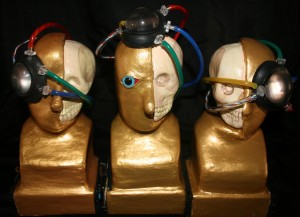
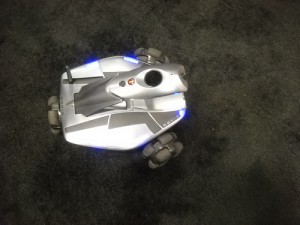
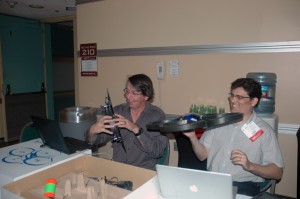
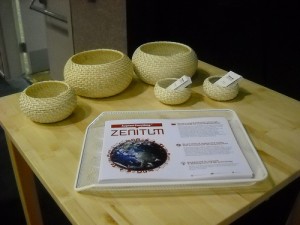
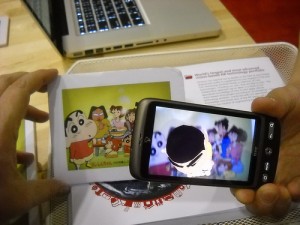
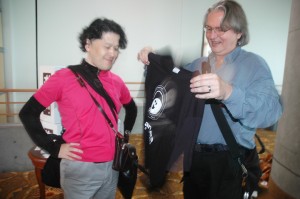
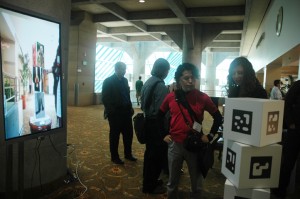
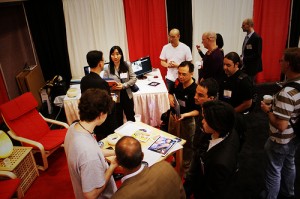
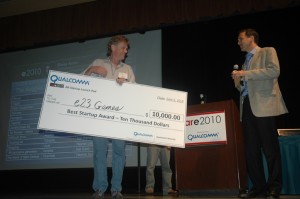


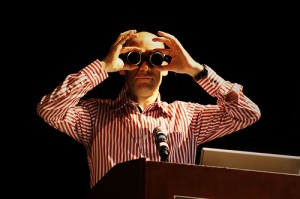
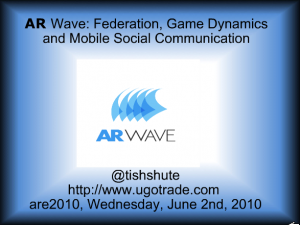
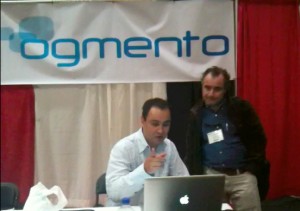
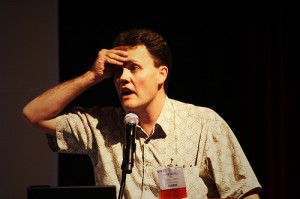
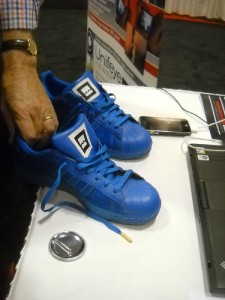
June 17th, 2010 at 9:59 am
the world “isnt” a medium?
sure it is.
anyhow. back to the show.
repeat and all.
August 7th, 2010 at 8:35 am
This really is seriously really good material, thanks.